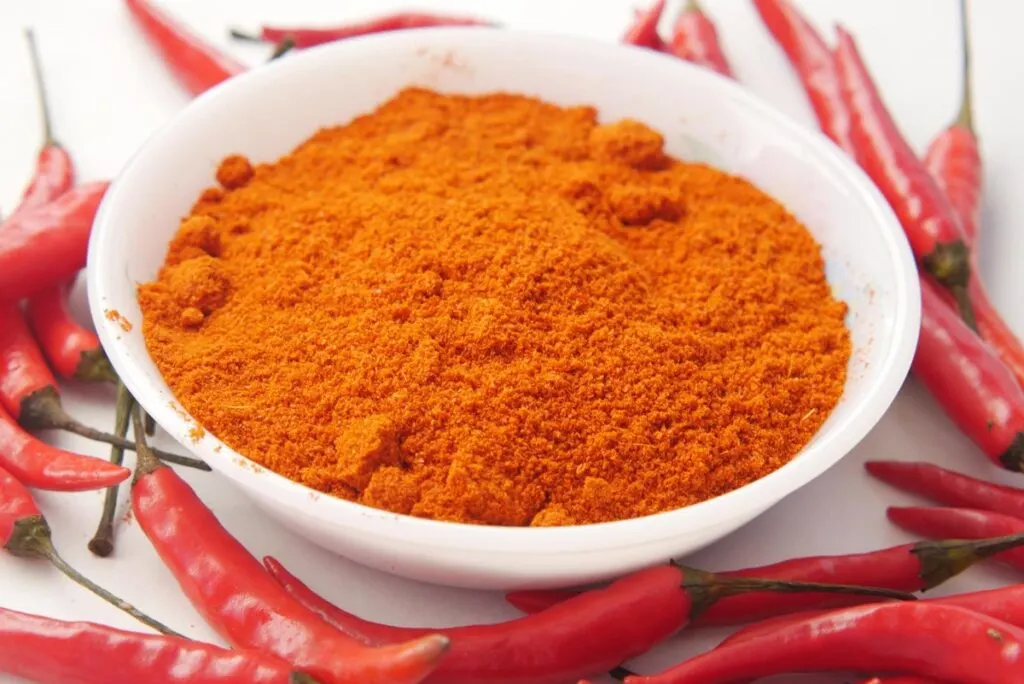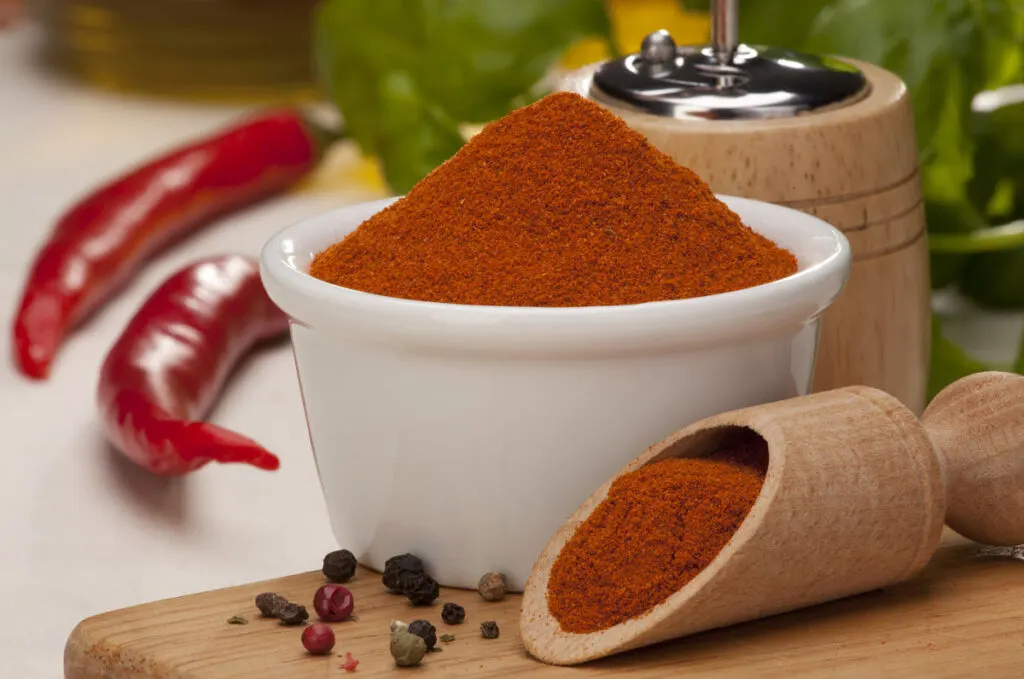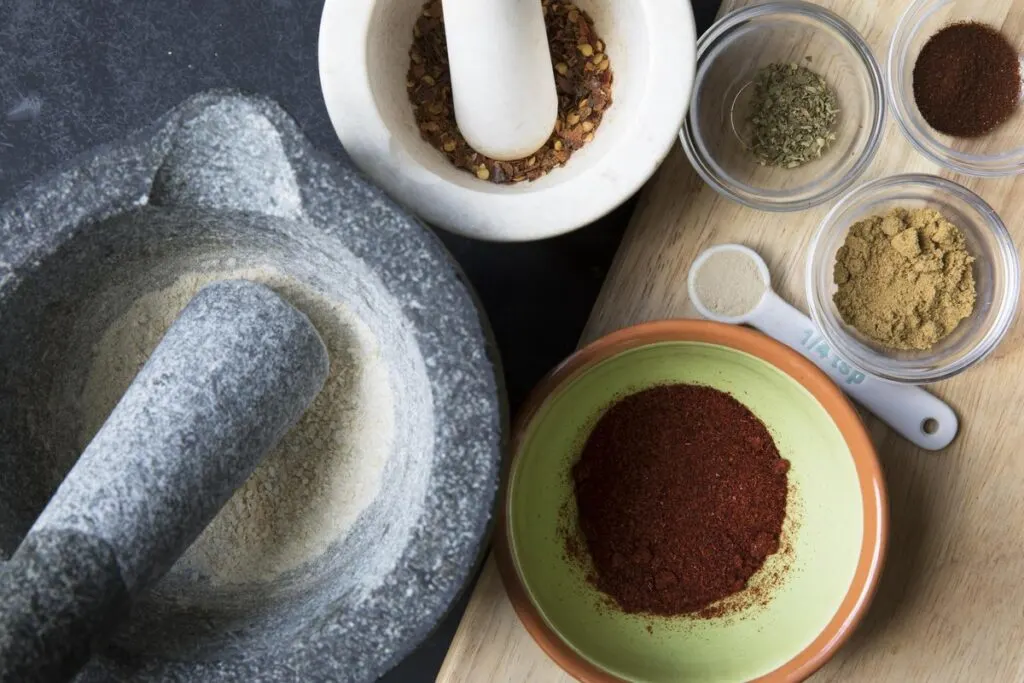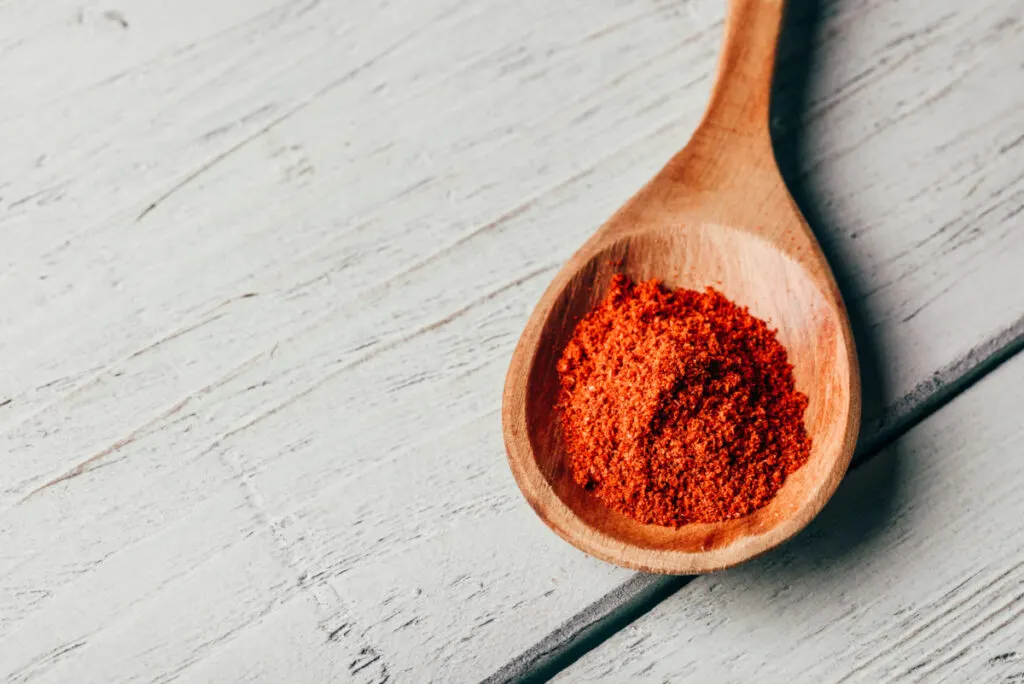My kitchen cabinet is a stranger to this spice. It always finds its way into some of my tastiest spicy chicken sauce recipes, different Asian sauces, and even when repurposing leftover curries. It’s a quick splash of heat for any occasion. But it does run out, and when it does, you’ll need a quick substitute for chili powder to use. Well, I’ve got several of the best.
You can substitute chili powder with paprika, ground cumin, ancho powder, and hot sauce. But this isn’t all you can swap chili powder with, so let’s hop into them all!

Jump To
🤷 What Is Chili Powder?
Chili powder is a spice blend made from dried chili peppers, often combined with other spices like cumin, garlic powder, and oregano. It adds heat and depth of flavor to dishes commonly used in Mexican, Tex-Mex, and Southwestern cuisine. The intensity and flavor of chili powder can vary depending on the types of chilies used and the proportions of other spices in the blend.
📌 Chili Powder Uses
Seasoning meats: Chili powder is commonly used to season meats such as beef, chicken, and pork.
Flavoring soups and stews: It can be added to soups, stews, and chili recipes to enhance the overall taste and provide warmth.
Sprinkling on snacks: Chili powder is often sprinkled on snacks like popcorn, roasted nuts, or chips for a spicy and flavorful twist.
Incorporating into sauces and marinades: It can be included in sauces and marinades for an added splash of heat.
Garnishing dishes: Chili powder can be used as a garnish to add color and a hint of spice to finished dishes like tacos, nachos, or salads.

💡 Best Chili Powder Substitutes
Homemade Chili Powder
Making your own homemade chili powder is a great way to add a unique and personalized touch to your cooking. Not only does it allow you to customize the heat level and flavor profile, but it also ensures that you are using fresh, high-quality ingredients. Just grind together dried chili peppers with other desired spices like cumin, garlic powder, and paprika until finely ground, and you have your powder. You can use a spice grinder, food processor, or a mortar and pestle.
Chipotle Chile Powder
1 teaspoon of chili powder = 1/2 teaspoon of chipotle chile powder
Chipotle chile powder is a fantastic smoky swap for chili powder. It has all the spice and texture you want but with a bonus delicious flavor. The smokiness comes from dried jalapeno peppers that are typically smoked over wood like oak or pecan. This gives it that iconic rich, smoky flavor and a deep red-brown color. You can grind and make your own using the same peppers or chipotle pepper substitutes instead.

Paprika
1 teaspoon of chili powder = 1 teaspoon of paprika
Paprika is an amazing substitute for chili powder, with different versions carrying anything from sweet to deep smoky flavors. The large selection of flavors and heat will leave you spoilt for choice. Just make sure it’ll match the flavor of the recipe when deciding on one. The sweet and peppery taste of normal paprika is pure flavor, but if you have trouble finding any or picking, you can use some paprika alternatives instead.
Cayenne Pepper/Powder
1 teaspoon of chili powder = 1/4 teaspoon of chopped cayenne pepper/powder
If you want a pure, fiery substitute for chili powder, then cayenne peppers or its powdered form is what you need. This is the spiciest swap on the list, with the intense heat making way for a nice, subtle earthiness. You can throw them in any sauce, rub, or marinade for that spicy kick. If you can’t find any or it’s too hot for you, you can use some cayenne pepper substitutes as a backup.

Ground Cumin
1 teaspoon of chili powder = 1 teaspoon of ground cumin
You can easily pick this one up in any grocery store or market as seeds or the powder itself. It has a subtle spice with a warm and earthy flavor that’s just right for swapping chili powder with. Ground cumin is a superb option to use as it’s just easy to use, convenient, and highly versatile in many of the same recipes. While the flavor may be somewhat lacking, you can throw in other ingredients to match it or make it even better.
Taco Seasoning
1 teaspoon of chili powder = 1 teaspoon of taco seasoning
Taco seasoning may be just the swap you need, thanks to its fiesta of flavors. It has a lively blend of spices and herbs, packing a zesty, smoky, and spicy array of flavors for your recipes. The use of chili powder in this seasoning, along with many other seasonings on the list is why it can be the perfect swap to use.

Crushed Red Pepper Flakes
1 teaspoon of chili powder = 1/2 teaspoon of crushed red pepper flakes
With how easy these are to use and pick up in grocery stores and markets, it’ll be hard to not pick them. A few crushed red pepper flakes can save you when you’re out of chili powder. They pack a spicer flavor, depending on the type used, with an equally similar taste. Just think of them as chili powder before being finely ground up. You can even use some chili flake substitutes instead for a wider range of choices.
Ancho Powder
1 teaspoon of chili powder = 1/2 teaspoon of ancho powder
Ancho powder will make for a tasty smoky swap with just the right spice and flavor. The dried and ground ancho chili peppers give everything this powder needs. It has that deep, delicious smokiness with just the right amount of kick for those chili powder recipes. A true all-rounder option. If you can’t find any or need a closer taste, you can use some ancho chili powder alternatives.

Hot Sauce
1 teaspoon of chili powder = 1/4 teaspoon of hot sauce
Using that leftover hot sauce on the table or shelf can prove to be a perfect substitute for chili powder. Although unusable as a dry rub, it’ll have just the right amount of spice and tang for those dishes you need it in. The brand will affect flavor and spice, but any type you have at home can be a great quick fix for no chili powder.
Cajun Seasoning
1 teaspoon of chili powder = 1 teaspoon of cajun seasoning
This is a delicious Southern spice that’ll work wonders as a chili powder swap. Cajun seasoning packs all the heat but with a flavor that’s 10x better. It has the ultimate spice blend of paprika, garlic powder, onion powder, cayenne pepper, and other seasonings. It’s everything you want in one convenient spice blend.
🧐 FAQs
You can enhance a variety of dishes with chili powder, including meats like chicken, beef, and pork, as well as soups, stews, and chili recipes.
Instead of chili powder or paprika, you can use a combination of spices like cumin, garlic powder, onion powder, oregano, and a pinch of cayenne pepper for heat.
For a substitute for chili powder in taco seasoning, consider using a combination of paprika, cumin, garlic powder, onion powder, oregano, and a pinch of cayenne pepper for heat.
